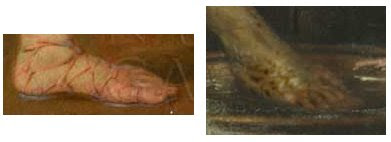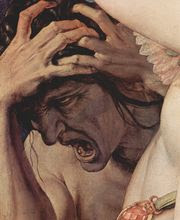Art and the Festering Foot Fungus
Gawain writes, in a spot of 'collegial pugilisation' directed at me:
Alas, this sort of “art history of ideas” is usually no more than the writer’s flight of fancy, a kind of free association of ideas. All it does is link some work of art, or some fragment of style to something else—some kind of signifier in the author’s brain—like Plato’s forms, or socio-economic theories, or moral concepts, or psychoanalysis. Unfortunately, proceeding by this excellent method it is possible to relate everything to everything else—“Paintings and The Proletarian Struggle”, certainly, but how about—“Paintings and The Festering Foot Fungus”?(Why 'unfortunately', I wonder?) My obvious response was Festering foot fungus? Now there's an idea, my dear alliterative Pole. It must have been the Stephen Potter in me. Thus, for my pugilisatory friend, and of course for the rest of you as well—
*
My readers may think the title quite a challenge. Not me. I knew immediately where first to turn: Venus, Cupid, Folly and Time, painted around 1547 by one of Gawain's favourites, Bronzino. Most of us here have seen the image, a grand hieroglyph of the mannerist age, but how many know the latest soundings of its mysteries? It turns out that Bronzino's Folly (also called Pleasure) provides an exquisite example of Cinquecento piede d'atleta, athlete's foot, or to give the affliction its proper scientific name, tinea pedis. Here is Folly's right foot, after a recent restoration of the panel by the good people at the National Gallery:

We can clearly see the effects of unchecked trichophyta between and along the toes; compare, for reference, a modern photograph of the condition:

Bronzino was no doubt working from a model—probably a friend or associate with the condition. Representations of tinea pedis are rare in the Renaissance, and other sorts of foot-disease were painted more often. For instance, in Poussin's Bacchanalian Revel of 1632 (left) we find a sort of scabrous welting of the whole foot, while Peter's foot in Tintoretto's Christ Washing the Feet of his Disciples (1565, right) seems to be experiencing the early stages of necrosis:

It would be appropriate, I wager, to conduct a full-length survey and analysis of the social history of foot disease in Renaissance painting; but this, of course, is beyond our present ambit, and so I offer merely a few remarks on the narrower subject of Bronzino's tinea in oils. Now, as I said, painted tineae are rare; the only other examples from this period that spring to mind—a Barocci Magdalene, and, if memory serves me aright, an allegorical leper by Scarsellino—are not to be found online; both of these, moreover, are at least a generation later than Bronzino's panel. So I know of no precedents in painting for this image, although I'm sure Gombrich could have pointed me in the right direction.
Contemporary medicine, on the other hand, provides a few clues. In 1546 a treatise was published in Venice by Girolamo Fracastoro entitled De Contagione et Contagiosis Morbis. This was the first book to work out fully a theory of the contagion and transmission of disease: Fracastoro denied the Hippocratic-Galenic doctrine that all illness results from an imbalance of humours. Thus, while the mediaeval Galenists had taught that skin diseases (including the mycosis or morbus militis—our tinea) were caused by a drying-out of the body's bile or phlegm, Fracastoro instead posited that they were transferred from one body to another by offensive particles called seminaria. (The latter word is related to the atomic semina of Lucretius, although Fracastoro's theory has more in common with the Neoplatonic concept of species or immaterial emanation: for more details, see this pdf.)
Fracastoro further linked skin-diseases in general, and mycosis in particular, to syphilis. This should not surprise us. Fracastoro was the master of syphilis; he dined and slept with it, and was its confidant, its Boswell, even its Milton. In 1530 he'd written an epic poem on the subject, in three books, entitled Syphilis sive morbus gallicus, which in fact is the origin of our word. (A French epitome of the book is online here.) The poem was a hit, and went through 50 editions in Latin alone. It would not be too much to say that syphilis was responsible for Fracastoro's career, and by golly, he was determined to capitalise on it. The precise relation between the 'master disease' and mere mycosis is never spelled out in the De Contagione, but perhaps he perceived the latter as a milder, even inchoate form of the loathsome cankers assigned to syphilis in the previous epic:
Protinus informes totum per corpus achoresWhat is important for our present purposes is that, according to J. F. Conway's pathbreaking 1986 analysis, syphilis itself appears allegorically in Bronzino's famous painting:
Rumpebant, faciem horrendam, et pectora foede
Turpabant.
Shapeless scabs burst at once through the body
and the dread face, and foully disfigured the breast.

Here syphilis, generating madness as it did for Nietzsche, is the gruesome result of the triumph of lust, symbolised by the principal action. Conway makes use of Fracastoro in his discussion of Bronzino; if we allow that the painter knew the Syphilis, we may go further and suggest that he also knew De Contagione, and thus date the Venus after 1546, possibly the following year. The cute cherub with the cutaneous mycosis joins the triumph of lust, scattering his poisonous petals upon the amorous couple—an incarnation of the seminaria that carry disease from one body to another. Bronzino was adding his small vote of support to Fracastoro's new theory, a bold move; but he hardly wanted to mar the fine, glossy surface of his ducal commission with something so ugly as a fungal infection, so he confined the disease to the boy's foot, a tiny detail, which indeed had been lost to dirt and varnish until the recent cleaning.
As so often, it is the smallest elements—for Morelli an ear or a hand, for me a tineatic foot—that yield the greatest interpretive riches. Gawain would not agree, but perhaps the rest of my readership will give the idea some credence.



9 comments:
Didn't I warn you?
As so often, it is the smallest elements . . . that yield the greatest interpretive riches.
Nothing whatever unfortunate about that, as you have so amply demonstrated.
Well done -- though I now see that visiting the Mutter was an unnecessary exercise!
What an impressive feet of scholarship. I’ll bet you’re a real fun guy to be around at parties. Etc.
Perhaps a follow-up post on foot pain in literature, starting with Oedipus and Achilles and taking it from there?
(Is it April fool’s day where you are?)
R: It's always April Fool's Day where I am!
Marty: thanks.
What's the citation for that pdf?
Isabelle Pantin, 'Fracastoro’s De Contagione and Medieval Reflection on ‘Action at a Distance’: Old and New Trends in Renaissance Discourse on Contagion', in Claire L. Carlin, ed., Imagining contagion in early modern Europe (Basingstoke: Palgrave Macmillan, 2005).
Couldn't you have clicked on it and found out for yourself?
I did. I couldn't find any info about the book or editor in the PDF.
OK, fair enough.
i did read it
Post a Comment